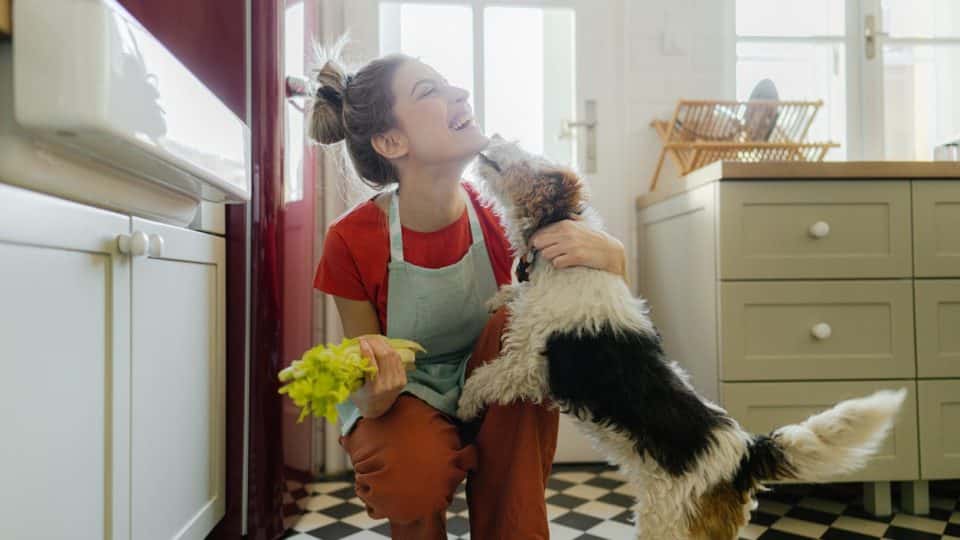Celery makes a great afternoon snack paired with hummus, peanut butter, or your favourite dipping sauce. But while you enjoy celery’s crunchy texture and taste, can your dog have some too?
Yes, dogs can eat celery in moderation, says Kathryn Dench, holistic veterinarian and chief scientific officer at Paw Origins. “In my clinical experience, about half of dogs seem to enjoy the texture and taste of celery, while others aren’t interested in eating it.”
If your dog falls in the interested half, learn about the potential nutritional benefits of celery below. Plus, discover the appropriate portion sizes for different breeds.
Is Celery Nutritious for Dogs?
Celery contains vitamins, minerals, antioxidants, and other nutrients that can support several different functions in dogs. Some of the specific health benefits of celery for dogs may include the following.
- Vision support. Celery contains beta-carotene, a precursor to vitamin A. This nutrient is essential for healthy vision in dogs, says Patrick Wilson, a veterinarian with Well Pet Coach.
- Healthy muscles and nerves. Dr Wilson says celery’s potassium content can help maintain proper muscle and nerve function.
- Strong bones. Celery also contains Vitamin K, which Dr Wilson says is important for blood clotting and bone health.
- Immune boost. Dr Dench says vitamins A, C, and K can all support a dog’s immune system.
- Reduced skin problems. Dr Wilson says the vitamin C content in celery can support healthy skin in dogs.
- Healthy cell function. Celery contains folate (vitamin B9). Dr Wilson says this vitamin supports cell division and healthy growth.
- Complements weight loss. Since celery is a low-calorie food, Dr Wilson says it’s a healthy treat for dogs watching their weight.
How Much Celery Can Dogs Eat?
Dr Wilson outlines the following celery portion guidelines for dogs of varying sizes. Remember to consult your vet before adding it to your pup’s diet. Generally, dogs should only eat bite-sized pieces of cooked or raw celery.
- For small dogs (under 9kg/20 lbs): about one to two teaspoons of finely chopped celery
- For medium-sized dogs (9-23 kg/20-50 lbs): around one to two tablespoons of chopped celery
- For large dogs (over 23 kg/50 lbs): up to five tablespoons of slightly larger chopped celery
Start by giving your pup a smaller serving and watch for any reactions, like an upset stomach. If your dog tolerates celery well, you can work your way up to the larger serving suggestion. Remember, even though celery is nutritious for dogs, non-dog food treats should only comprise 10% of your dog’s overall diet.
What Are the Risks of Dogs Eating Celery?
As you probably know, celery’s tough strings can get caught in your teeth. These strings can pose a choking hazard for dogs, especially for smaller breeds.
Remember that smaller dogs will need finely chopped pieces, while you can get by with larger chunks for bigger dogs. “You can also lightly steam chopped celery and mix it with your dog’s regular meals or other dog-friendly foods to make it easier to chew and digest,” Dr Wilson says.
What Other Veggies Are Safe for Dogs to Eat?
Looking for other dog-safe veggies to feed your pup? The following vegetables can make for a well-rounded dog diet. Remember to get your vet’s approval first and follow their serving-size recommendations.
- Carrots. High in beta-carotene, vitamin B6, fibre, and potassium. You can use carrots as an ingredient in dog food or serve bite-sized slices as a treat, says Nicole Savageau, a veterinarian with The Vets.
- Peas. A good source of vitamins A, C, and K, as well as protein and fibre. Peas can be added to dog food for an extra dash of protein.
- Pumpkin. Pureed pumpkin is high in fibre. If your dog’s digestive system needs a helping hand, you can mix a small amount into their favourite wet food.
- Green beans. A low-calorie source of vitamins B6 and K, as well as nutrients like potassium and magnesium. Green beans can make a good snack for dogs on diets.
- Sweet potato. Contains vitamins B6 and C as well as other nutrients, like fibre and beta-carotene. They can make a good carb source for dogs on grain-free diets.



